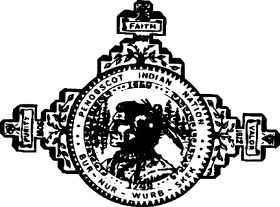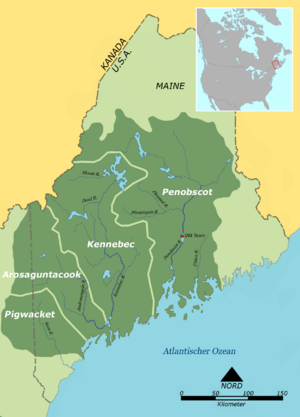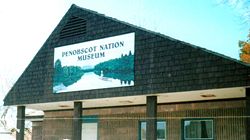Penobscot
The Penobscot (Panawahpskek) are a sovereign people indigenous to what is now Maritime Canada and the northeastern United States, particularly Maine. They were and are significant participants in the historical and present Wabanaki Confederacy, along with the Passamaquoddy, Maliseet and Mi'kmaq nations.
The word "Penobscot" originates from a mispronunciation of their name "Penawapskewi." The word means "rocky part" or "descending ledges" and originally referred to the portion of the Penobscot River between Old Town and Bangor. The tribe has adopted the name Penobscot Indian Nation.
Penobscot is also the name of the dialect of Eastern Abenaki (an Algonquian language) that the Penobscot people speak.
History
The Penobscot Indian Island Reservation is surrounded by the waters of the Penobscot River, in Penobscot County, Maine. This large river runs from their sacred mountain to the north, Mount Katahdin, down through the state to Penobscot Bay. It was along this river that they made seasonal relocations to the ocean for seafood, and then back inland for moose, deer, elk and bear hunting, as weather dictated.They lived in wigwams mostly.
Mount Katahdin remains a sacred place for these people, and as such travel to the top of the mountain is considered taboo. It is believed that an angry god resides in Pamola Peak. Pamola is a lower god in the spiritual belief system of the Penawapskewi. Pamola was an angry god, and because of his trickster behavior, was sent to Mt. Katahdin for eternity by the power of the highest god, Gluskab.
These people have a prehistoric tie to the river, such that it long ago became a part of their identity. The name of their tribe is the name of a place on the river where they spent most of their time throughout the year, a place "where the white rocks are," also identified as "where the river widens."[citation needed]
The insignia of this tribe, evidenced in their art and design, is the fiddlehead, in this case an immature frond of the Ostrich fern (Matteuccia struthiopteris L.) that grows along the banks of the Penobscot River. Fiddleheads of this fern are a delicacy and are one of the first "blooms" appearing after the harsh winters of the region, thus considered a gift from a spiritual higher power: a reward for having survived the winter.
By the time Joseph Orono was born in 1688, the Penobscot people had been in close contact with French Catholic missionaries and traders for over a generation, and Orono was himself of mixed ancestry, probably the grandson of Jean-Vincent d'Abbadie de Saint-Castin, The 3rd Baron Castin, who had settled at the mouth of the Penobscot River (the site of the present town of Castine, Maine) in the 1660s. Saint-Castin had married the daughter of Penobscot sachem Madockawando, and their son, Bernard-Anselme de Saint-Castin became the last leader of the tribe during its French alliance. His son Joseph Orono, who had to deal with the English, and then Americans, had light skin, blue eyes, and was a "zealous Catholic" according to contemporary accounts.
In the 1750s the English from nearby Massachusetts defeated the French in Acadia, which included the ancestral lands of the Penobscot. English settlers began to populate the Penobscot River valley from the 1770s, putting pressure on the tribe. Orono chose to accommodate the more numerous and better-armed white settlers as, in the course of his life-time, they gained virtually full control of Penobscot lands, restricting the tribe to its largest island-village (which they called "Indian Old Town" because it was assumed to be of ancient origin).
When the Revolutionary War broke out the Penobscots received a letter from the Provincial Congress of Massachusetts urging them to join with the "New English" against the "Old English". Orono agreed, urging his tribesmen to side with the Americans and offering to supply them braves, even making a trip to Boston and Newport, Rhode Island in 1780. The Americans did not take up the offer, however, likely fearing that it would empower the Penobscot.
In 1774 the English had founded a village called Stillwater, just below "Indian Old Town" at the site of a falls. Relations between the settlers and Indians had been sufficiently peaceful that, when Stillwater incorporated as a town in 1806, it named itself Orono, Maine after the recently-deceased Penobscot sachem, who had lived to the age of 113.
Culture
Religion
According to Abenaki mythology Tabaldak, the creator god, made humans and then Gluskab (several variants of whom were associated with different branches of the Abenaki, including Glooscap, Glooskap, Gluskabe Klooskomba) and Malsumis sprang from the dust on his hand. Gluskab and Malsumis both had the power to create a good world, but only Gluskab did so. Malsumis still seeks evil to this day.
Gluskab founded the Golden Age of the Earth by rendering the evil spirits of the Ancient Age smaller and safer, as well as teaching humanity how to hunt and fish, build shelter and all of the Abenaki's knowledge of art, invention and science. Gluskab's departure ended the Golden Age, though he is prophesied to return and renew it again.
Me-koom-wee-soo was Gluskab's assistant and wields an ivory bow. He has a fierce temper and gains weight as he gets more angry; eventually, it is said, he sinks into stone. Gluskab and Me-koom-wee-soo had an archery contest once; Me-koom-wee-soo fired an arrow into the top of Mt. Washington, creating a pond, while Gluskab's arrow created a hole in the sky that was then called msatawa (the Evening Star).
Gluskab realized the strain hunters can cause on an ecosystem. He asked a woodchuck spirit for help, and she gave him all the hairs off her belly, woven into a magical sac. This is why woodchucks have bald bellies. Gluskab then went to a mountain, where Tabaldak had placed a huge eagle (P-mol-a) that made bad weather by flapping its wings. After binding it, Gluskab realized some wind was necessary and loosened them slightly. Gluskab saved the world from a frog monster that swallowed all the planet's water. When Gluskab cut open the monster's belly, some animals jumped into the water and became fish. Some modern Wabanaki believe that Gluskab is angry at white people for not obeying his rules.
Glooscap (also spelled Gluskabe,Glooskap, Gluskabi, Kluscap, Kloskomba, or Gluskab) is a mythical culture hero, and "transformer" of the Wabanaki peoples. His name means "Man that came from nothing" or literally, "Man [created] only from speech."
Gluskabe created the first humans from the mud of the banks of the biggest, longest river in the area, the Penobscot River. There are many stories that relate to how different animals were created and how they attained their physical characteristics. Gluskabe also had run in with a trickster spirit, Pomola, until Gluscabe tired of his antics and banished Pomola to the western valley of Mount Katahdin, the holiest place on Earth. Gluscabe is thought to currently reside in this mountain, protector of the people of this land. Gluskabe created the Penobscot River, the headwaters of which are located at the base of Mount Katahdin, when he fought a greedy giant toad that had swallowed all of the water in the land. Gluskabe killed the toad, and thus created the Penobscot water shed, largest on the north east coast of what is now known as New England.
In Nicolar's (1893) self-published account of the Penobscot from the Creation Myth through stories of Penobscot history, precontact material culture, feats of shamanism, and ancient prophecies about the coming of the white man, he is known as Klose-kur-beh. Nicolar described Klose-kur-beh's journey in which he is instructed by the "Great Being" in both practical and spiritual knowledge. He is then charged with teaching the people that there is but one Great Spirit and how to follow the will of the Great Spirit. Joseph Nicolar, an elder and the grandson of the Penobscot's most famous shaman-leader, John Neptune, who held the office of Lieutenant-Governor of the tribe for 50 years, Nicolar brought to his task a wealth of traditional knowledge. His account illustrates how the Penobscot incorporated Christian teachings into their traditional belief systems, giving Klose-kur-beh the role of the savior.
Pamola (also known as Pamolai, P-mol-a, Pomola, and Bmola) is a legendary bird spirit that appears in Abenaki mythology. This spirit causes cold weather.
Specifically, according to the Penobscot, Pamola inhabited Mt. Katahdin, the tallest mountain in Maine. Pamola is said to be the god of Thunder and protector of the mountain. The Indians described him as having the head of a moose, the body of a man and the wings and feet of an eagle. Pamola was both feared and respected by the Indians, and his presence was one of the main reasons that climbing the mountain was considered taboo.
The spirit resented mortals intruding from down below. Because of this, the mountain was off limits to all below. It is also thought that it took its prisoners to Alomkik, located near Katahdin.
Pamola's name is now preserved on Pamola Peak, a summit on Katahdin at the eastern edge of the Knife Edge ridge. The Pamola Lodge of the Order of the Arrow is an honor camping society of the Boy Scouts of America; Pamola's image is commonly used on several of the society's insignia.
Contemporary Penobscot
The Penobscot became federally recognized through the Maine Land Claims Act, signed on March 15, 1980. Under the terms of the agreement, the Penobscot and Passamaquoddy tribes received a settlement of $81.5 million in return for relinquishing their rights to 19,500 square miles, for roughly 60 percent of the state of Maine. They mostly live on a reservation at Indian Island, which is near Old Town.
In 1973, the Penobscot tribe was one of the first Native American tribes to begin gambling enterprises with the opening of Penobscot High Stakes Bingo which is located on the reservation.
Notable Penobscots
- Joseph Orono (1688-1801) was a Penobscot chief or sachem who lived on the Penobscot River. In 1774 the English had founded a village called Stillwater, just below "Indian Old Town" at the site of a falls. Relations between the settlers and Indians had been sufficiently peaceful that, when Stillwater incorporated as a town in 1806, it named itself Orono, Maine after the recently-deceased Penobscot sachem, who had lived to the age of 113.
- Molly Molasses (1775-1867), real name Mary Pelagie (or Balassee) Nicolar, was known to everyone as Molly Molasses. She was born in a Penobscot camp in today's Bangor, a powerful shaman who would heal the sick but also put a curse on those who angered her (Brown 2008).
- Joseph Nicolar, Penobscot Tribal Representative to Maine State Legislature and author of 1893 book The Life and Traditions of the Red Man.
- Louis Sockalexis, was born on the Penobscot Indian reservation near Old Town, Maine in 1871. His grandfather was Chief of the Bear Clan. He is one of the first native Americans to play major league baseball.
- Andrew Sockalexis was born into a family of athletes on January 11, 1891, the younger cousin of Louis Sockalexis. He was a marathon runner who competed in the 1912 Stockholm Olympic Games.
- Molly Spotted Elk, born on November 17, 1903 in the Penobscot reservation in Maine, was a successful vaudeville dancer and appeared in the silent film The Silent Enemy (1930). However, the discrimination she suffered because she was Native American led her to pursue a dancing career in Paris (McBride 1997).
- Charles Norman Shay, the grandson of Joseph Nicolar, a decorated war hero of Omaha Beach, Normandy in World War II, he received the French Legion of Honor medal on November 6, 2007 (Loring 2007).
ReferencesISBN links support NWE through referral fees
- Bourque, Bruce J. 2004. Twelve Thousand Years: American Indians in Maine. Lincoln, NE: Bison Books. ISBN 0803262310
- Calloway, Colin G. (ed.). 1991. Dawnland Encounters: Indians and Europeans in Northern New England. Lebanon, NH: University Press of New England. ISBN 0874515947
- Doherty, Katherine M., and Craig A. Doherty. 1996. The Penobscot. Franklin Watts. ISBN 0531157644
- Godfrey, E. John. 1872. The ancient Penobscot, or Panawanskek. The Historical Magazine and Notes and Queries concerning The Antiquities, History, and Biography of America XXI(II) (February, 1872) 85-92. Retrieved October 1, 2008.
- MacDougall, Pauleena. 2004. The Penobscot Dance of Resistance: Tradition in the History of a People. New Hampshire. ISBN 1584653817
- Vetromile, Eugene. [1856] 2008. Indian Good Book - For The Benefit Of The Penobscot, Passamaquoddy, St. John's, Micmac, And Other Tribes Of The Abnaki Indians. Read Books. ISBN 978-1408614785
- Waldman, Carl. 2006. Encyclopedia of Native American Tribes. New York, NY: Checkmark Books. ISBN 978-0816062744
- Nicolar, Joseph. [1893] 2007 (Annette Kolodny (ed.)). The Life and Traditions of the Red Man: Reading Line: A rediscovered treasure of Native American literature. Duke University Press. ISBN 0822340283
- Eckstorm, Fannie H. 1980. Old John Neptune and Other Maine Indian Shamans. Orono, ME: University of Maine Press. ISBN 0891010440
- Speck, Frank G. [1940] 1997. Penobscot Man. Orono, ME: University of Maine Press. ISBN 0891010955
- McBride, Bunny. 1997. Molly Spotted Elk: A Penobscot in Paris. Norman, OK: University of Oklahoma Press. ISBN 0806129891
- Loring, Donna. 2007. A Salute to Charles Norman Shay Bangor Daily News. Retrieved October 1, 2008.
- Brown, Jason K. 2008. Molly Molasses Acacia Artisans. Retrieved October 1, 2008.
External links
- Official Website of the Penawapskewi
- Maine Land Claim Maine Indian Tribal-State Commission, Hallowell, Maine, February 14, 1995.
- Asticou's Island Domain: Wabanaki Peoples at Mount Desert Island 1500–2000 National Park Service
- Petition of the Chiefs of the Penoscot Tribe of Indians, January 1821 Atlantic Salmon History Project
- Address by Penobscot Indian Chief John Neptune, July 11, 1820 Atlantic Salmon History Project
- Portraits
- Native Languages of the Americas: Penobscot
- SOCKALEXIS, LOUIS FRANCIS (1871-1913)
Credits
New World Encyclopedia writers and editors rewrote and completed the Wikipedia article in accordance with New World Encyclopedia standards. This article abides by terms of the Creative Commons CC-by-sa 3.0 License (CC-by-sa), which may be used and disseminated with proper attribution. Credit is due under the terms of this license that can reference both the New World Encyclopedia contributors and the selfless volunteer contributors of the Wikimedia Foundation. To cite this article click here for a list of acceptable citing formats.The history of earlier contributions by wikipedians is accessible to researchers here:
The history of this article since it was imported to New World Encyclopedia:
Note: Some restrictions may apply to use of individual images which are separately licensed.



